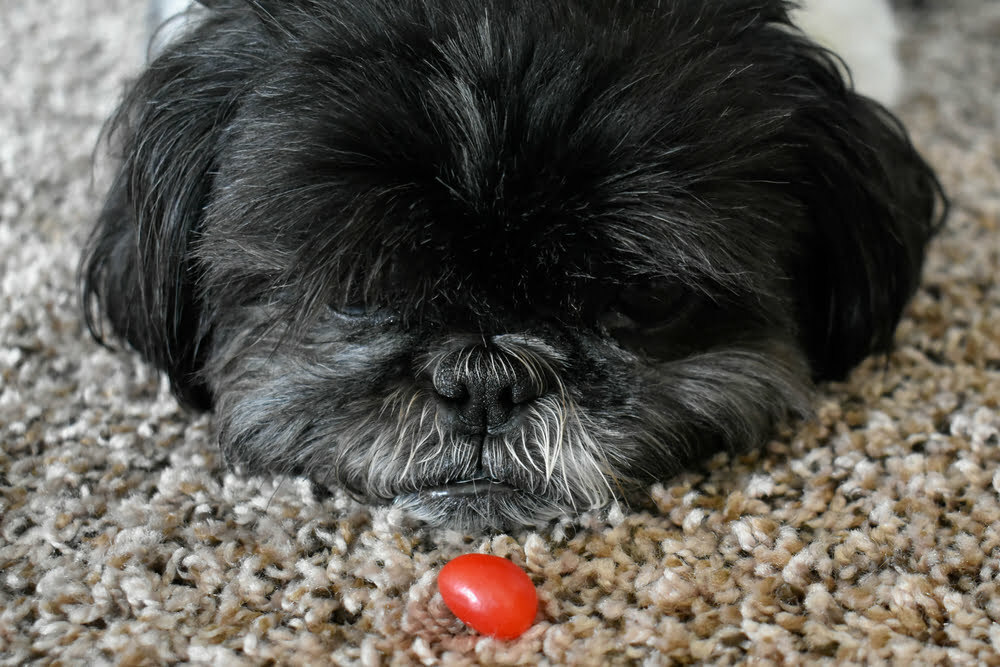Jelly beans, as you probably already know, are a sweet treat that is intended for humans, not dogs. They are packed full of sugar, artificial flavors, colorings, and possibly other toxic ingredients such as xylitol or caffeine.
Unfortunately, many of the ingredients that are found in jelly beans may not be the best for dogs.

Even if you haven’t intentionally given your dog a snack of jelly beans, we all know how mischievous they can be at times, and it isn’t uncommon for dogs to get hold of something that they are not supposed to.
You leave the room for 2 minutes, and before you know it, your half-eaten packet of jelly beans is no more.
However, what you are probably wondering is whether dogs can eat jelly beans and if it is safe for them to eat them or not. This is something that we are going to explore in this article.
Can Dogs Eat Jelly Beans?
No, dogs cannot eat jelly beans. If they eat one or two accidentally, then this may be alright, but too many can become dangerous. It is not recommended to feed jelly beans to your dog, but it is possible for accidents to happen.
So, if your dog does manage to get hold of some, you will need to check the ingredients to find out whether they are going to be harmful to them. Whether or not they become ill after eating jelly beans will also depend on how many they have eaten.
Some types of jelly beans can lead to a mild tummy upset, but it is usually a good idea to contact your vet for advice if you are concerned.
You can tell them the ingredient list, and they will be able to tell you if there is anything concerning them. Even if your dog appears to be well, sometimes it is better to be safe than sorry.
Why Are Jelly Beans Bad for Dogs?

Jelly beans are something that you should avoid giving to your dog as they do not provide any nutritional value, and feeding them to your dog can cause them serious harm if certain ingredients are present.
Jelly beans can also be particularly harmful if your dog suffers from any pre-existing health conditions, like diabetes, a heart condition, liver disease, skin allergies, gut problems, or obesity.
Both puppies and older dogs are at a higher risk of becoming dangerously ill due to testing things that they shouldn’t have.
You should always check the ingredients to make sure that there are no particularly harmful ingredients. Some ingredients to be aware of that can be harmful to your dog are:
- xylitol
- caffeine
- pectin or starch
- sugar
- flavorings
- Xylitol
Xylitol
For those who don’t know, xylitol is an artificial sweetener that can be deadly, so immediate action should be taken if your dog consumes this. It is a common artificial sweetener that is often used in sugar-free candy and can be found in jelly beans.
It can be deadly if consumed by your dog as it causes a sudden drop in blood sugar to dangerously low levels, which is called hypoglycemia. This can happen within 30 minutes of eating xylitol, but this will depend on how much has been ingested.
Some dogs can take up to 18 hours after consuming it before they show any symptoms, which is why you should not wait around for any symptoms of toxicity. If you know that they have eaten xylitol, call your vet.
The signs of hypoglycemia from xylitol toxicity are:
- drowsiness
- vomiting
- excessive drooling
- staggering
- loss of consciousness or slow to respond
- seizures
- coma
Xylitol consumption can even cause liver failure in some dogs, and in some cases, it can be fatal if left untreated.
Caffeine
Not always, but in some instances, caffeine can be found in jelly beans, and this can be fatal for a dog that has eaten them.
Caffeine comes from the same compound as theobromine, which is the chemical toxin that causes chocolate toxicity in dogs. It isn’t widespread for jelly beans to obtain caffeine, but it can sometimes be the case.
The effect caffeine has on your dog would be much more severe than it would on humans. Even if they only consume a small amount of it, signs of toxicity can occur.
Once a dog has eaten caffeine, it will be absorbed into its gut within 45 minutes. Symptoms will usually start to present themselves after around 2 hours, so it is important that you get your dog seen by a veterinarian as soon as possible.
The signs of caffeine toxicity are:
- restlessness
- high body temperature (hyperthermia)
- fast heartbeat
- seizures
- shaking
- abnormal reaction to touch or movement around them
Unfortunately, like xylitol, caffeine toxicity can be fatal. Both caffeine and xylitol poisoning are veterinary emergencies. You should call your vet as soon as you suspect that any of these ingredients have been consumed by your dogs, as the sooner it is caught, the better.
Sugar
There is absolutely no nutritional value to sugar in candy, so it is not beneficial to your dog in any way. You should always choose an alternative treat for your dog. The sugar is only present to provide a sweeter taste, and while your dog might like the taste, too much sugar can cause various problems.
If your dog does eat a large amount of sugar, it is likely that they will experience vomiting or diarrhea. If they get sugary treats often, they will gain too much weight, and overweight dogs are much more likely to develop diabetes and heart disease.
This extra weight will also put more pressure on their bones and joints, making them more likely to develop arthritis. Sugar is also bad for their teeth and gums.
